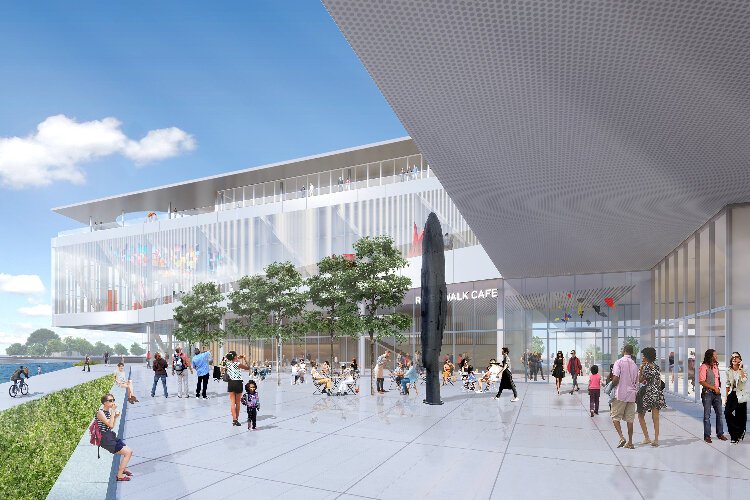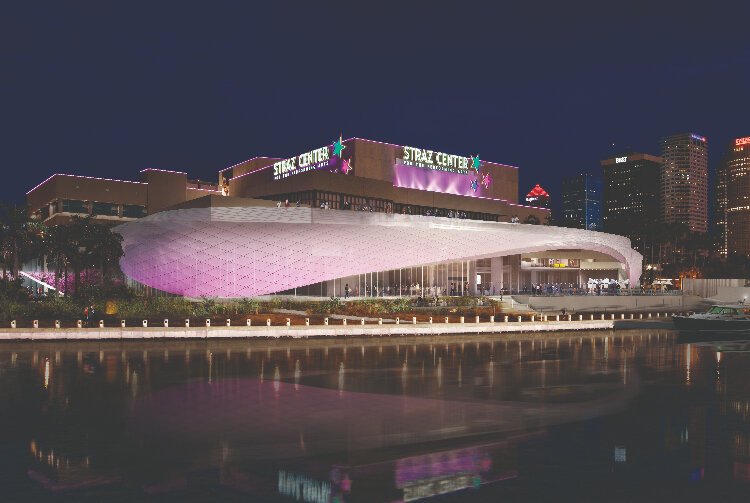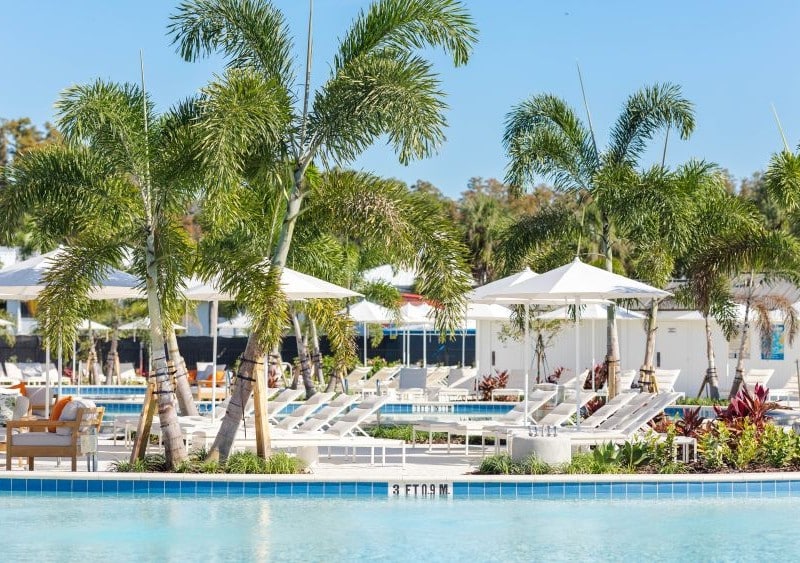Elaborate expansions for riverfront jewels Tampa Museum of Art, the Straz, Tampa Convention Center
Along Tampa's downtown riverfront, the Tampa Convention Center completed an ambitious expansion this year. The Tampa Museum of Art and Straz Center for the Performing Arts are next.
In the 1980s, Tampa’s marketers came up with the slogan, “America’s Next Great City.’’ Some people scoffed. Back then, downtown Tampa went to sleep after 5. The city’s too-small convention center was Curtis Hixon Hall. The big attraction behind it was the Requin, a World War II submarine moored in the Hillsborough River.
Now, nearly 40 years later, the slogan seems to fit.
Accolades have poured in over the last few years. In 2023, Bankrate, the financial services company, named Tampa the 5th top place to live in the United States. U.S. News & World Report this year ranked it the best city in the nation to retire. In 2022, WalletHub, the finance company, called it one of the most fun cities in the country. In 2021, Forbes Magazine named it the top emerging tech city in the U.S.
The boom in highrise, high-end apartments downtown, teeming with financially comfortable retirees and young professionals, along with plenty of dining, bar and entertainment choices, has transformed the once-gritty port town into a place people want to be.
New highrises keep sprouting, among them a 31-story luxury residential tower called AER, for Arts and Entertainment Residences, which is under construction next door to the David A. Straz Center for the Performing Arts. Expected to open next spring, the 334-unit luxury tower is in the heart of the downtown River Arts District, the stretch of arts and enterprise that follows the east shore of the Hillsborough River, connected by the celebrated Riverwalk.
Three jewels, the Straz Center, the Tampa Museum of Art and the Tampa Convention Center, are all adding more sparkle to the river with elaborate expansions.
Tampa Museum of Art Centennial Renovation and Expansion
The Tampa Museum of Art, founded 103 years ago, recently finished what it called the centennial renovation. The $15 million project reallocated “back of the house’’ space to add seven additional galleries – for a total of 15- plus an expansion of the Vinik Family Education Center, adding classrooms for ceramics, multimedia arts and digital arts. It will nearly quadruple the number of children served yearly from 14,000 to 63,000. The lobby has been remodeled into a sculpture atrium and gallery. The glass facade around the building allows “the public to see art without coming inside,’’ according to the museum’s web site.

In 2024, the museum plans to break ground on a $98 million Centennial Renovation and Expansion project that will nearly double its size. The 51,000 square-foot, four-story addition will jut out over a terrace toward the river. Glass walls will give those inside a view of the river, the University of Tampa campus and downtown. It will take two years to build, says Dr. Michael Tomor, the Penny and Jeff Vinik Executive Director of the Tampa Museum of Art.
“I think it’s a game changer for all of Hillsborough County and West Central Florida in that (it) is a stunning piece of architecture that will be iconic to Central Florida and to the cultural asset landscape,’’ says Tomor.
The next expansion will allow the museum to enhance its education program to film multimedia and culinary arts, Tomor says.
It will include a 150-seat auditorium that overlooks the river, where the museum can present lectures, recitals and multimedia performances. The museum will also install a 40 ft. by 30 ft. digital exhibition wall on the second floor of the addition.
“That will allow us to expand our exhibition programming to multimedia art on an ongoing basis. It will be the largest of its type in an art museum in the state of Florida,’’ Tomor says. “There are thousands of artists around the world that are working now in digital and multimedia formats.’’
A large event space in the new addition will feature a view of downtown Tampa. The museum can stage exhibitions there or have a 500-plate seated dinner for private events. A sculpture terrace will be visible to people on the Riverwalk. A fourth-floor rooftop terrace will include a bar for gatherings of up to 100 people, plus a demonstration kitchen for culinary arts.
An indoor-outdoor restaurant off the Riverwalk, open to the public, will operate seven days a week from morning to evening on the first floor, Tomor says. Some 80 percent of the museum’s expansion will be from private donations, with money from Hillsborough County and the City of Tampa’s Community Redevelopment Area (CRA) making up the rest.
Straz Center transformation
The art museum’s longtime neighbor, the Straz Center, plans to start work in 2024 on an $80 million expansion that will present a dramatic vision along the waterfront, with a “veil’’ that undulates along the river and north facades. The work, funded by a combination of CRA funds and private donations, is expected to be complete for a grand opening in early 2027.
The original performing arts center, which opened in 1987, was a key feature in sparking the downtown boom, notes Greg Holland, president and CEO of the Straz.
“One of the key reasons it was built on what then was sort of the quiet end of downtown was to spur development in this part of Tampa,’’ he says. “You can see what it’s done. Not only did it spur incredible development, but with Judy Lisi (his predecessor) and this board of trustees working together to do all of this, they’ve also made the Straz Center the largest cultural institution in the Southeastern United States and one of the top performing arts centers in the country.”

The expansion will add more planning, rehearsal and office space and increase by 30 percent the space in the Patel Conservatory, the center’s accredited performing arts and education center.
“Besides our classes, that’s where our community outreach programs live, including our military veterans programs, our healing in the arts programs,’’ Holland says. “We have educators and artists that go out and work in the community (and) serve almost 60,000 people in shelters, in community centers and schools.’’
The project will expand the space around the current Riverwalk stage where free performances are held frequently. A rooftop bar and terrace will be open to the public but can also be used for large private gatherings.
The center will relocate and expand its three restaurants – Maestro’s Restaurant, Maestro’s Cafe in the Lobby of the Morsani Theater, and Maestro’s outside bar and grill, facing the river.
Two large buildings built behind the veil on the center’s north end will house restaurants and catering kitchens for Straz events.
“In that beautiful veil on the north end of the complex, we’ll have a new fine dining restaurant,” Holland says. “We’ll have a new cafe. The cafe that’s currently in the Morsani lobby will move out of the Morsani lobby into its own space. The river grill and bar will become an on-the-river bistro.’’
Tampa Convention Center
South of the Straz and the art museum, the Tampa Convention Center finished a $44.5 million expansion in the summer, adding two stories with 18 new meeting rooms with floor-to-ceiling glass windows, all overlooking Seddon Channel.
“It’s going to allow us to retain a lot of our existing conventions that have started to expand, and accommodate that demand for new space,’’ says Juan Lopez, sales and marketing manager of the convention center, which opened in 1990. “It’s also going to allow us to attract certain events (that) we were just slightly too small for.’’

Tourist Development Tax and Community Redevelopment Area tax revenues, bonds and city general fund money paid for the project.
Lopez says it’s already paying off.
“We do have one group specifically coming in March; the group is called Pesol,” he says. “It’s an educational group that committed to Tampa as a result of the new meeting space for us to be able to accommodate their size.’’
Still, the convention center needs to expand its main trade show floor, he notes.
“Our trade show floor is 200,000 square feet, and that’s where we really need to remain competitive and to take our destination to the next level,” Lopez says. “It needs to be more in the 350,000 to 400,000 square foot range.’’
The feasibility process is just starting, Lopez says, “with the hope that in the next four years or so that we’ll be looking to do another substantial expansion for the center.’’
The expansion of the art museum and the Straz should enhance convention business, Lopez says.
“It allows us to showcase Tampa and all of our amenities,” he says. “When we’re going out to solicit and attract conventions, a lot of time groups will look to sites such as the museum to have off-site functions, or also to the Straz Center for entertainment after scheduled activities for their attendees.’’
For more information, go to tampamuseum.org; strazcenter.org; and tampa.gov/tcc .















